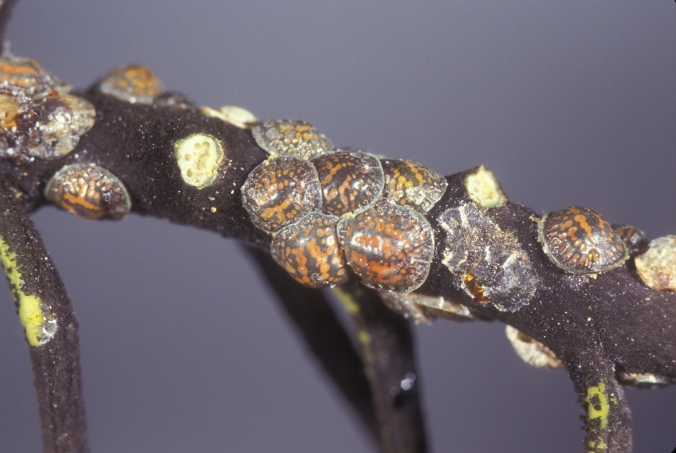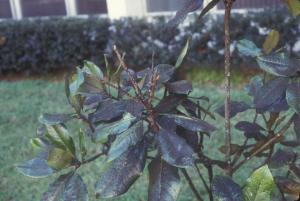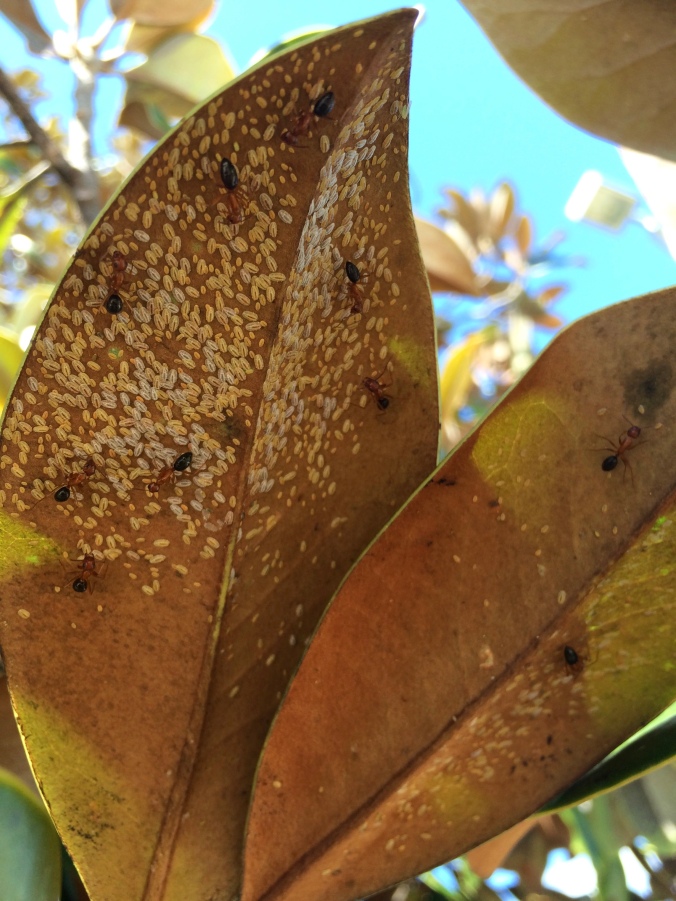I was outside of Orlando today at the UF/IFAS Mid Florida Research and Education Center. As I was walking through a landscape, I noticed several ants actively crawling over the branches and leaves of a southern magnolia tree. This caught my attention and upon closer inspection, I found a pretty large population of tuliptree scale, Toumeyella liriodendri.
The tuliptree scale was first documented in the late 1700s on yellow poplar but didn’t garner attention until the the early-to-mid 1900s, as a significant pest of yellow poplar timber production. This insect is native to eastern North America throughout the range of yellow poplar, but is also found in California on ornamental plantings. Tuliptree scale has been reported to feed on a variety of plants in Florida, including magnolia, buttonbush, cape jasmine, and loblolly-bay.
These insects have one generation per year throughout most of their range, but have been found in all life stages during the winter in Florida. The population I stumbled upon today overwintered as nymphs, which have begun actively feeding and will become adults in early summer. Once adults, the females will move to the bark and begin to produce up to 3600 eggs per individual. As you might imagine, populations can build up quickly.

Tuliptree scale adult females Photo: J.S. Castner UF/IFAS
As the weather warms, nymphs begin to feed more actively. This pest is a soft scale insect, which means it extracts sap from the tree and excretes honeydew as waste (unlike armored scales). Over time, this honeydew accumulates on surfaces beneath the infestation, which makes it sticky and facilitates growth of black sooty mold. Sooty mold is both unsightly and reduces the plant’s ability to grow. In addition to sooty mold, severe scale infestations can cause branch dieback, sparse foliage, and potentially death.

Sootymold from tuliptree scale infestation Photo: J.S. Castner UF/IFAS
Tuliptree scale has several natural enemies including: Lady beetles, parasitoid wasps, a predaceous moth larva, and a syrphid fly larva. In nature, this team of natural enemies usually keeps this scale below damaging levels. However, most urban landscapes are far from natural, which mixes things up, although it doesn’t mean they are out of the picture.
Another factor that mixes things up are ants. The honeydew that these scales excrete is a tasty treat rich in sugars for many ant species. In fact, over 10 species of ants have been found tending to tuliptree scales for their honeydew. In turn, the ants protect the scales from predators like lady beetles, lacewings, and flies. This symbiosis is great for the scales and ants but can be a pain for landscape managers.

Ants tending to tuliptree scale nymphs on the underside of magnolia leaves Photo: A.G. Dale

Several magnolia leaves heavily infested with tuliptree scale being tended to by ants Photo: A.G. Dale
When scouting your landscape plants, keep an eye out for active ant populations and sooty mold growth because it may indicate that scales are hanging out nearby. Managing scale insects is requires monitoring, persistence, and proper timing. Now (the nymphal stage) is a good time to target these scales because they are smaller and more susceptible to control than the adult life stage. Horticultural oils can be effective with repeated treatments and full coverage of the infested plant material. Systemic or translaminar products can also reduce populations and get ingested while the insect is feeding. Keep non-target effects of applying these products in mind as they relate to your IPM program. Are your other management strategies compatible with the product(s) you choose? As always, read the product label and follow it. I hope to have an up-to-date Florida scale insect management guide available in the near future.
Here is a short video I took of the ants tending the tuliptree scales: https://youtu.be/G3AidoVXTFI
Having trouble finding the right treatment for tulip tree scale, caom hsomeoneelp me identify products needed
LikeLike
Systemic products like imidacloprid or dinotefuran, or insect growth regulators like pyriproxyfen provide the best control. Insecticidal soaps and horticultural oils can also provide equivalent control if applied diligently. See, https://adamgdale.files.wordpress.com/2016/08/mg00500.pdf for more info.
LikeLike